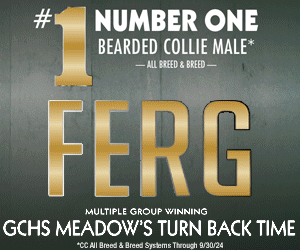New Breeds Debut at Westminster
258 – March 2017
by Joan Harrigan
 Benched shows like Westminster are a great opportunity to meet the newly-recognized breeds and the people devoted to them. In 2010, 173 breeds and varieties were exhibited at Westminster; in 2017, there were 200—small wonder that the evening judging no longer comes close to finishing on time. Exhibitors at a breed’s inaugural Westminster know that they have a chance to make history, as well as a first impression. They come prepared with fliers and patience — they will tell their story many times during the day. Three very different breeds made their debut in 2017: one developed in America, one in Hungary, and one in exotic North Africa.
Benched shows like Westminster are a great opportunity to meet the newly-recognized breeds and the people devoted to them. In 2010, 173 breeds and varieties were exhibited at Westminster; in 2017, there were 200—small wonder that the evening judging no longer comes close to finishing on time. Exhibitors at a breed’s inaugural Westminster know that they have a chance to make history, as well as a first impression. They come prepared with fliers and patience — they will tell their story many times during the day. Three very different breeds made their debut in 2017: one developed in America, one in Hungary, and one in exotic North Africa.
The American Hairless Terrier
The Rat Terrier made its Westminster debut in 2014—readers of Faulkner and other southern literature knew this breed as the Feist. The American Hairless Terrier is a natural mutation of the Rat Terrier; unlike the Chinese Crested or the Xolo, it is also completely hairless except for its eyebrows and whiskers. The foundation for the breed was a hairless puppy named Josephine who was born in a Louisiana litter of Rat Terriers in the early 1970s. Josephine was given to Edwin and Willie Scott, who quickly became devoted enthusiasts, and a new breed was born.
“Genetically, AHTs are Rat Terriers,” says Kathy Spears of Centralia, Washington. “The breed standards are very similar.” Spears likens the texture of an AHT’s skin to a warm chamois—she was more than a little offended when someone compared it to “warm bologna.” She explains that in the Crested, Xolo, or Pe- ruvian Inca Orchid, the gene for hairless- ness is dominant. In the AHT, it is a recessive gene; to be hairless, the dog must carry two copies of the mutation. In fact, there are coated AHTs, and they are shown alongside their hairless counterparts. Coated AHTs may have natural or docked tails, while the hairless dogs must be shown with natural tails. What is the difference between a coated AHT (called a Coated Carrier within the fancy) and a Rat Terrier? Genetically, there is little to no difference, though Coated Carriers must carry a recessive hairless gene.
Click here to read the complete article258 – March 2017
Short URL: https://caninechronicle.com/?p=121726
Comments are closed











